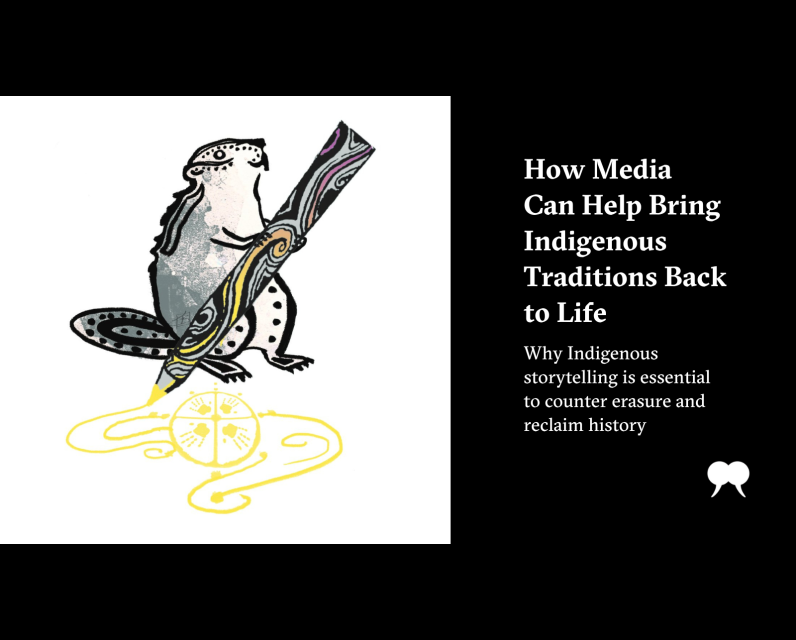How Media Can Help Bring Indigenous Traditions Back to Life

My first week as a journalist was the same week the Truth and Reconciliation Commission released the summary of its Final Report. I was twenty-two, a recent graduate of a university named after Christopher Columbus. The Huffington Post had hired me to be their “Native Issues Fellow,” essentially a glorified intern working mostly from behind a desk in New York City. My first headline, written in that tabloid-y left-of-centre HuffPost style: “Canada Just Confronted Its ‘Cultural Genocide’ of Native People. Why Can’t the U.S. Do the Same?” Ten years later, I find myself asking strikingly similar questions about what it means to reckon with genocidal histories—to get the story right but come to different conclusions.
I’ve now spent a decade reporting on Indigenous communities in Canada and the United States. I’m a member of the Canim Lake Band Tsq’escen in British Columbia, an Indian under Canada’s Indian Act. My father was born at St. Joseph’s Mission, an Indian residential school near Williams Lake, BC, and found minutes later abandoned in a trash incinerator. He had a hard upbringing, bouncing from one house to the next. He got off the rez as soon as he could, found his way to Emily Carr College of Art and Design in Vancouver, and landed a job at a fine art printmaking studio as far away from Canim Lake as he could imagine: New York. That’s where he met my mother, a loud, quick-witted Irish Jewish New Yorker, at a bar outside the city. According to legend, Dad took a gold feast ladle earring out of his lobe, gave it to Mom, and that’s how I came to be.
-
Read more from our Truth and Reconciliation series:
- Intro
- Truth
- Child Welfare
- Economic Development
- Gender
- Land
After moving around for Mom’s jobs—Minneapolis, Miami—my parents settled in Oakland, California, a city with a large urban Indian community. Not long after that, Mom and Dad split on account of Dad’s alcoholism.
In the wake of the loss of my larger-than-life Indian artist dad, my mother did everything she could to keep me connected to my culture. She brought me home to the Canim Lake Indian Reserve almost every Christmas and most summers. She drove us down to the Intertribal Friendship House in East Oakland, where every Thursday night they held powwow drum and dance practice. When I expressed interest in dancing, Mom learned to bead so I could have a proper “coming out” into the powwow circle. Before I was a journalist reporting on Indian country, I travelled the powwow circuit, dancing in competitions across the US and Canada. One time, at the Lillooet New Year’s Powwow in BC, I even won a horse. An Apache guy who was a sort of stand-in for my father nicknamed me “Champion,” as in “champion dancer.”
Journalism, the powwow trail, and my upbringing have given me a transnational view of Indian country. As an Indian from Canada raised and working in the US, I’m often asked about the differences between the two countries. In both, Indigenous peoples have lost almost all our lands. Our populations were reduced to fractions of their former might. Some were killed off entirely. Then our children were taken away to segregated church-run schools where they were stripped of language, culture, and lifeways. In Canada, there was a high-profile truth and reconciliation process to address the wrongs of Indian residential schools. In the US, there was an inquiry into Native American Boarding Schools. But it never received the same level of media and public attention as its Canadian counterpart. In the US, Indians are mostly powerless and invisible. In Canada, Indians are also mostly powerless, but we are at least visible, and so Canadians feel “sorry.” North of the border, there’s some desire to know our story and make things right.
Like dancing, storytelling has become a way for me to understand and recover who I am against that history of cultural genocide. Nearly a decade after the TRC’s Final Report, I co-directed Sugarcane, an Academy Award–nominated documentary about an ongoing investigation into abuse and children who went missing from St. Joseph’s Mission, the Indian residential school where my family was sent and my father was born. Making that film reshaped how I understand my role as a storyteller. Now, I see my responsibility as not only to unearth truths hidden by colonization but also to bring our traditions back to life. That’s why my first book, We Survived the Night, is written in the form of a “Coyote story,” a traditional trickster narrative from my own culture. Because, in the story of a rabble-rousing creator, destroyer, deadbeat, and survivor like Coyote, I have come to see and understand a great deal of my father, my people, and myself.
A decade into this era of truth and reconciliation, I still find myself asking the same questions about what it will take to get our stories right and make our truths known. In the wake of near total cultural annihilation, Indigenous peoples are now bringing back what was taken. Not only because our ways, like the Coyote stories, were nearly wiped off the face of the earth. But because our traditions have always gotten the stories of this land right.
The post How Media Can Help Bring Indigenous Traditions Back to Life first appeared on The Walrus.
Comments
Be the first to comment